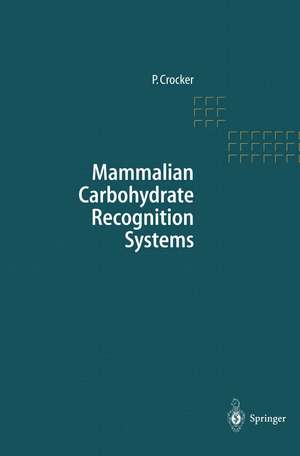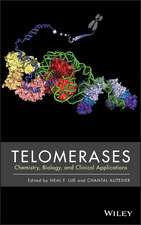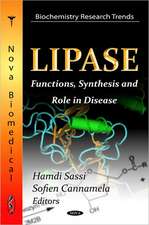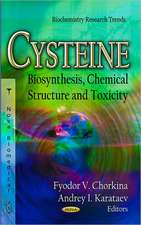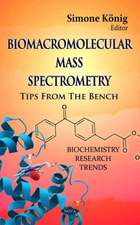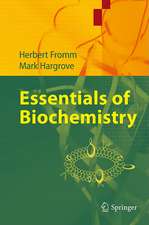Mammalian Carbohydrate Recognition Systems: Results and Problems in Cell Differentiation, cartea 33
Editat de Paul R. Crockeren Limba Engleză Paperback – 21 iul 2012
Din seria Results and Problems in Cell Differentiation
- 18%
 Preț: 1391.73 lei
Preț: 1391.73 lei - 15%
 Preț: 597.16 lei
Preț: 597.16 lei -
 Preț: 387.96 lei
Preț: 387.96 lei - 5%
 Preț: 373.33 lei
Preț: 373.33 lei -
 Preț: 382.18 lei
Preț: 382.18 lei -
 Preț: 385.08 lei
Preț: 385.08 lei - 15%
 Preț: 644.82 lei
Preț: 644.82 lei - 15%
 Preț: 634.00 lei
Preț: 634.00 lei -
 Preț: 387.20 lei
Preț: 387.20 lei -
 Preț: 387.75 lei
Preț: 387.75 lei - 15%
 Preț: 643.34 lei
Preț: 643.34 lei -
 Preț: 382.18 lei
Preț: 382.18 lei -
 Preț: 394.71 lei
Preț: 394.71 lei -
 Preț: 390.08 lei
Preț: 390.08 lei -
 Preț: 381.43 lei
Preț: 381.43 lei -
 Preț: 385.47 lei
Preț: 385.47 lei -
 Preț: 385.47 lei
Preț: 385.47 lei -
 Preț: 391.22 lei
Preț: 391.22 lei - 18%
 Preț: 1227.04 lei
Preț: 1227.04 lei - 20%
 Preț: 561.68 lei
Preț: 561.68 lei - 5%
 Preț: 1418.27 lei
Preț: 1418.27 lei -
 Preț: 386.00 lei
Preț: 386.00 lei -
 Preț: 377.95 lei
Preț: 377.95 lei -
 Preț: 391.61 lei
Preț: 391.61 lei -
 Preț: 388.52 lei
Preț: 388.52 lei - 18%
 Preț: 1380.63 lei
Preț: 1380.63 lei - 18%
 Preț: 1220.12 lei
Preț: 1220.12 lei - 15%
 Preț: 642.51 lei
Preț: 642.51 lei - 15%
 Preț: 640.37 lei
Preț: 640.37 lei - 18%
 Preț: 1222.49 lei
Preț: 1222.49 lei - 18%
 Preț: 946.41 lei
Preț: 946.41 lei -
 Preț: 387.38 lei
Preț: 387.38 lei - 18%
 Preț: 1228.47 lei
Preț: 1228.47 lei - 15%
 Preț: 642.51 lei
Preț: 642.51 lei - 18%
 Preț: 1663.00 lei
Preț: 1663.00 lei - 18%
 Preț: 1225.62 lei
Preț: 1225.62 lei
Preț: 639.25 lei
Preț vechi: 752.06 lei
-15% Nou
Puncte Express: 959
Preț estimativ în valută:
122.34€ • 127.25$ • 100.100£
122.34€ • 127.25$ • 100.100£
Carte tipărită la comandă
Livrare economică 14-28 aprilie
Preluare comenzi: 021 569.72.76
Specificații
ISBN-13: 9783642536700
ISBN-10: 3642536700
Pagini: 272
Ilustrații: XVII, 252 p.
Dimensiuni: 155 x 235 x 14 mm
Greutate: 0.39 kg
Ediția:Softcover reprint of the original 1st ed. 2001
Editura: Springer Berlin, Heidelberg
Colecția Springer
Seria Results and Problems in Cell Differentiation
Locul publicării:Berlin, Heidelberg, Germany
ISBN-10: 3642536700
Pagini: 272
Ilustrații: XVII, 252 p.
Dimensiuni: 155 x 235 x 14 mm
Greutate: 0.39 kg
Ediția:Softcover reprint of the original 1st ed. 2001
Editura: Springer Berlin, Heidelberg
Colecția Springer
Seria Results and Problems in Cell Differentiation
Locul publicării:Berlin, Heidelberg, Germany
Public țintă
ResearchCuprins
Lectins of the ER Quality Control Machinery.- 1 Introduction.- 2 Structural Aspects.- 3 Calnexin and Calreticulin in Quality Control of Glycoprotein Folding.- 4 Calnexin and Calreticulin in Glycoprotein Degradation.- 5 Regulation of Calnexin/Calreticulin-Substrate Interaction.- 6 Conclusions.- References.- MR60/ERGIC-53, a Mannose-Specific Shuttling Intracellular Membrane Lectin.- 1 Discovery.- 2 Structural Features.- 3 Intracellular Mannose-Specific Animal Lectins Are Homologous to Leguminous Plant Lectins.- 4 Oligomerization and Sugar Binding Activity.- 5 Cytological Features.- 6 Deciphering the Role of MR60/ERGIC-53: Looking for Highly Specific Oligosaccharide and Natural Glycoprotein Ligands.- 7 Concluding Remarks.- References.- The Cation-Dependent Mannose 6-Phosphate Receptor.- 1 Introduction.- 2 Intracellular Trafficking of the MPRs and Lysosomal Enzymes.- 3 Primary Structure and Biosynthesis of the CD-MPR.- 4 Carbohydrate Recognition by the CD-MPR.- 5 Concluding Remarks.- References.- Galectins Structure and Function — A Synopsis.- 1 Introduction.- 2 Structure, Specificity, and Endogenous Ligands.- 3 Genes, Expression, and Targeting.- 4 Functional Effects.- 5 Biological Roles and Biomedical Use.- 6 Summary and Conclusions.- References.- Structure and Function of CD44: Characteristic Molecular Features and Analysis of the Hyaluronan Binding Site.- 1 Synopsis.- 2 Cell Adhesion Proteins.- 3 Molecular Structure of CD44.- 4 Biological Functions and Ligands of CD44.- 5 The Link Protein Module.- 6 Analysis of the Hyaluronan Binding Site in CD44.- 7 Comparison of Carbohydrate Binding Sites.- 8 Conclusions.- References.- Structure and Function of the Macrophage Mannose Receptor.- 1 Functions and Biological Ligands of the Mannose Receptor.- 2 Structure of the MannoseReceptor.- 3 Mechanisms of Carbohydrate Binding by the Mannose Receptor.- 4 The Mannose Receptor Family.- 5 Conclusions.- References.- The Man/GalNAc-4-SO4-Receptor has Multiple Specificities and Functions.- 1 Introduction.- 2 Oligosaccharides Terminating with the Sequence SO4-4GalNAc?1,4GlcNAc?1,2Man? (S4GGnM) Are Found on the Pituitary Glycoprotein Hormones of All Vertebrates.- 3 Terminal ?1,4-Linked GalNAc-4-SO4 Determines the Circulatory Half-life of LH.- 4 The Ga1NAc-4-SO4-Receptor: A Receptor with Multiple Carbohydrate Specificities and Functions.- 5 Functional Significance of the Man/Ga1NAc-4-SO4-Receptor.- 6 Future Directions.- References.- Sialoadhesin Structure.- 1 Introduction.- 2 Sialoadhesin Carbohydrate-Binding Domain Structure and Function.- 3 Comparison with Other Sialic Acid-Binding Proteins.- 4 Sialic Acid Mediated Cell Adhesion.- 5 Conclusion.- References.- Ligands for Siglecs.- 1 Introduction.- 2 Structures of Siglecs.- 3 Carbohydrate Recognition.- 4 Perspectives.- References.- Functions of Selectins.- 1 Selectin Structure and Expression.- 2 Functions Common to All Selectins.- 3 Differential Functions of Selectins.- 4 Signaling through Selectins.- 5 Selectin Ligands.- 6 Phenotype of Selectin-Deficient Mice.- 7 Selectin Ligand Deficiencies.- 8 Selectins and Disease.- 9 Summary.- References.- Carbohydrate Ligands for the Leukocyte-Endothelium Adhesion Molecules, Selectins.- 1 Introduction.- 2 Carbohydrate Ligands for E-Selectin.- 3 Carbohydrate Ligands for L-Selectin.- 4 Oligosaccharide Ligands for P-Selectin.- 5 Perspectives.- References.- Structures and Functions of Mammalian Collectins.- 1 Introduction.- 2 Mannose-Binding Lectin (MBL).- 3 Surfactant Protein A (SP-A).- 4 Surfactant Protein D (SP-D).- 5 Cell Surface Receptors for Collectins.- 6SP-A and SP-D Gene Knock-out Mice.- 7 SP-A and SP-D in Human Diseases.- 8 Bovine Collectins: Conglutinin (BC) and Collectin-43 (CL-43).- References.
Textul de pe ultima copertă
In the last decade there has been a great expansion in our knowledge of the existence, nature and functions of mammalian carbohydrate binding proteins. This book covers the structures and postulated functions for the major classes of mammalian carbohydrate binding proteins. These include intracellular lectins involved in diverse functions such as protein synthesis quality control, targetting of lysosomal enzymes and in the secretory pathway. In addition, several chapters are devoted to other major families of lectins that are found at the cell surface or in extracellular fluids which are involved in various recognition functions such as cell-cell interactions in inflammation and recognition of pathogen carbohydrates in host defence.
Caracteristici
This book provides an up-to-date coverage of the major carbohydrate binding proteins found in mammals
